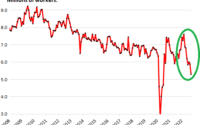Cleveland Fed’s Mester sees rates above 5% amid ‘too high and too stubborn’ inflation
Cleveland Fed President Loretta Mester said Tuesday night she sees interest rates moving above 5% and rates adjusted for inflation staying in positive territory for “some time.”
“Precisely how much higher the federal funds rate will need to go from here and for how long policy will need to remain restrictive will depend on how much inflation and inflation expectations are moving down,” Mester said in a speech at the Money Marketeers of New York University.
How quickly these pressures are resolved will depend, in part, on supply chain challenges easing and demand slowing down, Mester noted.
The Federal Reserve last month raised interest rates by 0.25% to a target range of 4.75%-5%, the highest since 2007. Mester is not a voting member of the FOMC this year, but will vote on policy in 2024.
In her speech on Tuesday, Mester called inflation “too high and too stubborn.”
“The disaggregated data show that the inflation stubbornness is due mainly to the prices of services,” Mester said. Mester said core services excluding housing, a measure Fed Chair Jerome Powell has highlighted in recent months, has not shown many signs of improving, noting this measure, “tends to be sticky, is correlated with wage inflation, and is a much larger share of the overall index than goods or housing, since consumers spend a larger share of their income on these services.”
The Fed’s preferred measure of inflation — the personal consumption expenditures price index excluding volatile food and energy prices — climbed 4.6% in February from a year earlier, data out last week showed.
“So while the level of inflation is lower than it was last summer, in February, the year-over-year measures of both total PCE inflation and core PCE inflation were in the 4.5%-5% percent range, which is well above our 2 percent goal,” Mester said.
‘Sound and resilient’
As has become custom among Fed officials in recent weeks Mester acknowledged the challenges facing the banking system following the collapse of three banks in March but said, “The U.S. banking system is sound and resilient.”
Mester said tensions in the banking system as a result of Silicon Valley Bank and Signature Bank’s failures, could result in banks tightening lending, leading to households and businesses becoming more cautious in their spending. She said the Fed will take this into account when setting rates.
“Directionally, we know that credit conditions are likely going to be somewhat tighter, and we will be assessing the magnitude and duration of these effects on the economic outlook to help us calibrate the appropriate path of monetary policy going forward,” she said.
In the wake of the bank failures, Mester noted that bringing down inflation and financial stability are both important and that the Fed will adjust the monetary path if needed.
“[Both] price stability and financial stability are important for a healthy economy, and I do not see a tradeoff between the two,” Mester said.
Adding: “A healthy financial system provides valuable credit, risk-management, payment, and liquidity services to households and businesses in support of a sound economy. An unstable financial system can propagate adverse macroeconomic shocks over broad economic sectors and over time to the detriment of macroeconomic stability.”
Click here for the latest economic news and economic indicators to help you in your investing decisions
Read the latest financial and business news from Yahoo Finance
[ad_2]
Source link


